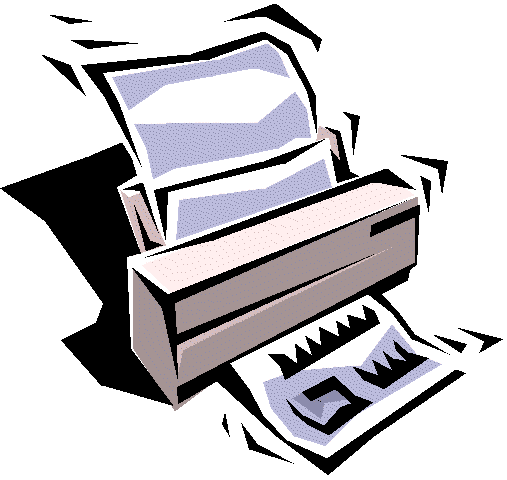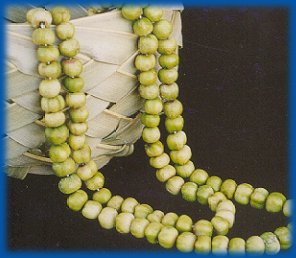 Kaua'i The mokihana lei represents the Island of Kaua'i. The fruit of
the mokihana tree may be found seeking direct sunlight only in the wild and only
in the tropical rainforests of the Island of Kaua'i and the Big Island. Its
anise scented, leather fruit must be strung within a few hours of picking and
often serves as a sachet.
Kaua'i The mokihana lei represents the Island of Kaua'i. The fruit of
the mokihana tree may be found seeking direct sunlight only in the wild and only
in the tropical rainforests of the Island of Kaua'i and the Big Island. Its
anise scented, leather fruit must be strung within a few hours of picking and
often serves as a sachet. Known as the "Garden Island", Kaua'i is often regarded as the most scenic of all the islands; it is smaller than the other major islands, but with the same physical features. The island is easily accessible by car and almost everything is within a two hour drive; it's a picture perfect spot for honeymooners and those wishing to escape a hectic lifestyle. Take time and visit the stunning Kalalalau Valley on the na Pali Coast with its awesome cliffs and Waimea Canyon.
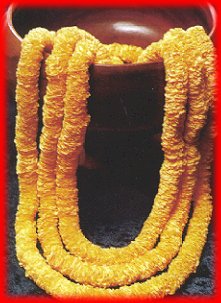 O'ahu
The official lei of the
Island of O'ahu is the fragrant ilima. It is composed of hundreds of flowers
strung together so only the edges are seen. Each requires many, many hours of
work. In ancient times, ilima leis were only worn by high chiefs. Today the lei
is often given to public officials.
O'ahu
The official lei of the
Island of O'ahu is the fragrant ilima. It is composed of hundreds of flowers
strung together so only the edges are seen. Each requires many, many hours of
work. In ancient times, ilima leis were only worn by high chiefs. Today the lei
is often given to public officials.
"The Gathering Place", O'ahu is said to be where "Aloha begins!". Discovered
roughly a thousand years ago by Polynesian explorers from the Marquesas, O'ahu
has become a melting pot for people from all over the world. Sugar and pineapple
plantations were abundant and today many historical sights await the mainland
tourist: Waikiki Beach, 'Iolani Palace, Hawai'i Maritime Museum, Bishop Museum,
Polynesian Cultural Center, and of course, Pearl Harbor/Arizona Memorial. The
Battleship Missouri and the Punchbowl are but a few of the many
possibilities. Festivals and fairs abound as well, and there are many
eco-tourist and sports activities including golf and tennis to try.
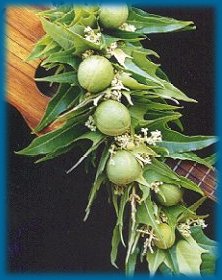 Moloka'i Any plant the
ancient voyaging Polynesians chose to bring had to serve many useful purposes.
Among the kuku tree's many uses, its bark, flowers, and nuts are all used
medicinally. Also, its white flowers, fruit, and leaves are strung as the kukui
lei, which represents Moloka'i, whose symbolic color is a silvery green.
Moloka'i Any plant the
ancient voyaging Polynesians chose to bring had to serve many useful purposes.
Among the kuku tree's many uses, its bark, flowers, and nuts are all used
medicinally. Also, its white flowers, fruit, and leaves are strung as the kukui
lei, which represents Moloka'i, whose symbolic color is a silvery green.
Most of the people who live here are of native Hawaiian ancestry. moloka'i has
been called "The Friendly Isle", and is also known as the "Most Hawaiian Isle".
It is the least developed of the major Hawaiian islands. Three separate shield
volcanoes make it an island of surprising geographical diversity.
Eastern Moloka'i receives ample rainfall, and its streams and waterfalls have
cut deep valleys in the land. Western Moloka'i is much drier, and consists for
the most part of rolling hills and plateaus. Along the northeast shore, the
world's highest sea cliffs drop into the ocean, while the south shore generally
has a plain edge with coral reef. As the least developed of the Hawaiian
Islands, it has no supermarkets, no traffic signals, no elevators, and no
buildings over three stories.
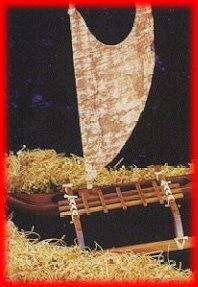 Lana'i
"Kauna'oa kahakai" translates to "the
beach orphan vine". It is an entwining vine having tiny white blossoms and may
be found along roadsides and beaches, growing over plants and even up trees as
it seeks direct sunlight. The strands are twisted, then twined over each other,
forming kauna'oa, the official lei of the Island of Lana'i.
Lana'i
"Kauna'oa kahakai" translates to "the
beach orphan vine". It is an entwining vine having tiny white blossoms and may
be found along roadsides and beaches, growing over plants and even up trees as
it seeks direct sunlight. The strands are twisted, then twined over each other,
forming kauna'oa, the official lei of the Island of Lana'i.
Lana'i is a dome with a single ribbed edge running across the middle of the
island. Until a few years ago, the island was the world's largest working
pineapple plantation. Two beautiful resorts await the discriminating traveler on
this magnificent island. They are all inclusive and offer guests a truly
superior accomodation with world class ammenities and spectacular undeveloped
natural setting. It is a remarkable place to visit and a memorable place to
return to again and again.
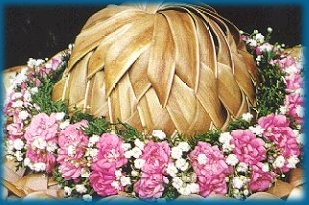 Mau'i
Introduced in the early 1800's,
this beautiful flower was soon called lokelani (heavenly rose) by the
Hawaiians who were fascinated by its color and fragrance. The Territorial
Legislature officially established the lokelani as the flower of Maui in 1923.
It is greatly prized and often worn in haku leis (a method of lei making which
involves intertwining flowers with greenery) for parades, special holidays, and
honorary ceremonies.
Mau'i
Introduced in the early 1800's,
this beautiful flower was soon called lokelani (heavenly rose) by the
Hawaiians who were fascinated by its color and fragrance. The Territorial
Legislature officially established the lokelani as the flower of Maui in 1923.
It is greatly prized and often worn in haku leis (a method of lei making which
involves intertwining flowers with greenery) for parades, special holidays, and
honorary ceremonies.
Maui County is comprised of three islands-Maui, Moloka'i, and Lana'i. Maui,
often called the "Valley Isle" is the second largest of the Hawaiian Islands,but
almost everything is easily accessible by car, and the roadways are among the
most scenic in Hawai'i-especially the Road to Hana!
Climb Mt. Haleakala (The House of the Sun) long before day break, and await the
most breathtaking sunrise you may ever see anywhere. Or, relax and enjoy a
bicycle ride down the mountainside, walk dozens of hiking trails, or visit
dozens of historical points of interest. In winter, the national pasttime on the
island is Whale Watching-either from shore or out on a boat where you can cry "Thar
She Blows" and you see a great tail of a whale high above the waves!
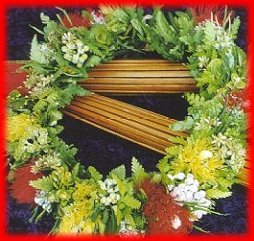 The
Big Island Lehua
blossoms grow on the native ohi'a, the first tree daring enough to sprout from a
new lava field. The pom-pom stamens are sacred to the volcano goddess Pele and
were used by the ancient Hawaiians in a potion to lessen the pain of childbirth.
The red, salmon, pink, or yellow flowers are quite showy and energetically
participate in the Big Island of Hawai'i's official lei.
The
Big Island Lehua
blossoms grow on the native ohi'a, the first tree daring enough to sprout from a
new lava field. The pom-pom stamens are sacred to the volcano goddess Pele and
were used by the ancient Hawaiians in a potion to lessen the pain of childbirth.
The red, salmon, pink, or yellow flowers are quite showy and energetically
participate in the Big Island of Hawai'i's official lei.
By Hawaiian standards, the Big Island is HUGE. It's almost twice the size of all
of the rest of the Hawaiian Islands combined and four times the size of Rhode
Island on the mainland. And it has an active volcano as a major attraction which
you can visit by car, tour bus, or see from above you as you take a helicopter
tour of the island.
There are two major "sides" to the island: Kona, where you will find major
resort accomodations, golf, horseback riding, tennis, and sport fishing; and
Hilo, which includes Hawai'i Volcanoes National Park, Rainbow Falls, and Waipi'o
Valley, the valley of kings.
